evolution unit
1/75
There's no tags or description
Looks like no tags are added yet.
Name | Mastery | Learn | Test | Matching | Spaced |
|---|
No study sessions yet.
76 Terms
gradualism
Hutton - The theory that evolution occurs slowly but steadily
Uniformitarianism
Charles Lyell's idea that geologic processes have not changed throughout Earth's history - occurred over vast stretches of time and were happening at a gradual, uniform pace
Malthus
studied populations and noticed that organisms had a "struggle for existence"
natural selection
process by which certain heritable traits become more or less common in a population over successive generations due to their effects on an organism's ability to survive and reproduce in its environment.
reproductive isolation
Separation of species or populations so that they cannot interbreed and produce fertile offspring
derived characters
characteristics that appear in recent parts of a lineage but not in its older members
homologous structures
Structures in different species that are similar because of common ancestry.
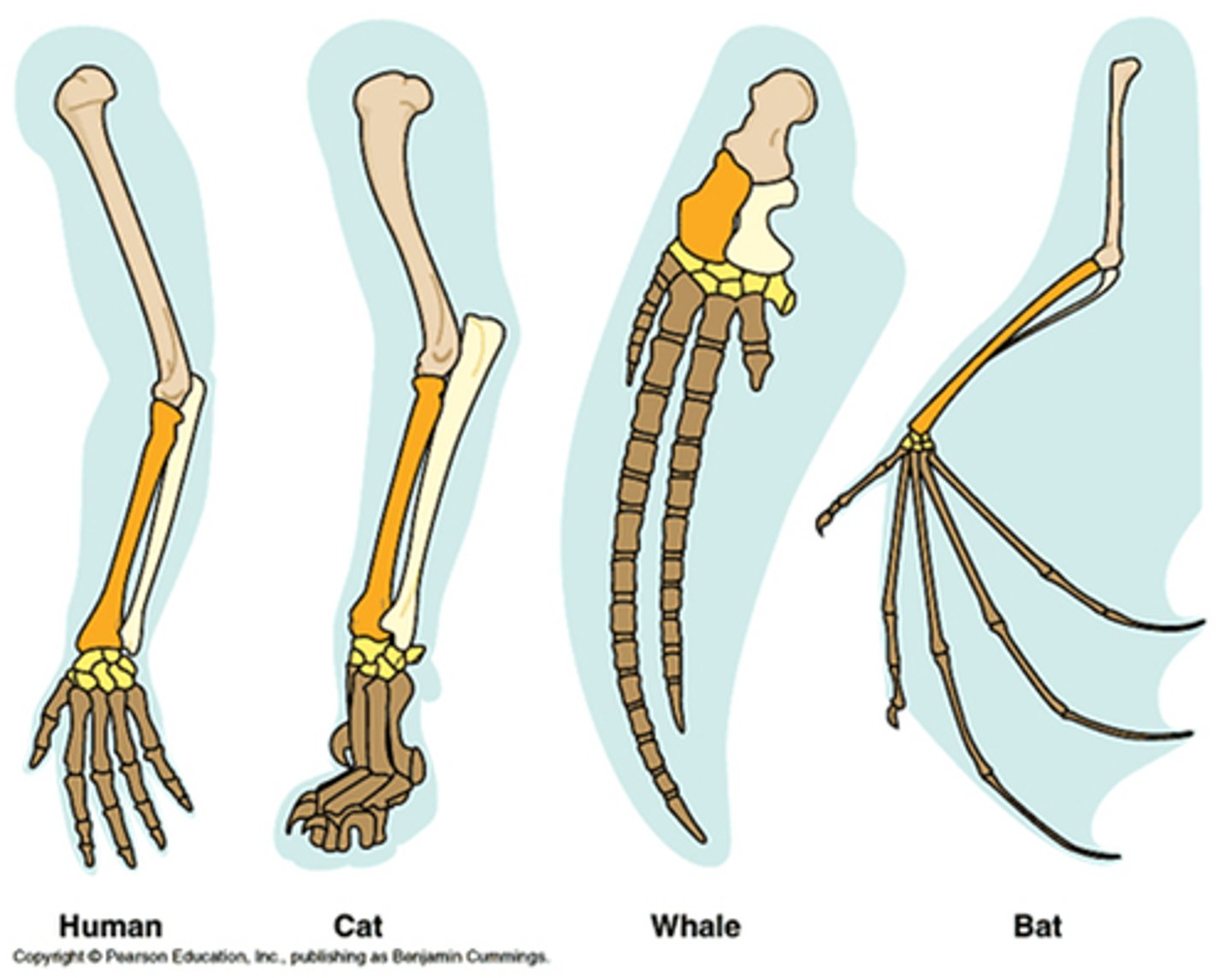
fossil record
Evidence for evolution coming from samples of fossils of various times that show homologies.
bottleneck effect (genetic drift)
a sudden reduction in population size due to a change in the environment - certain alleles that survive by random can reproduce
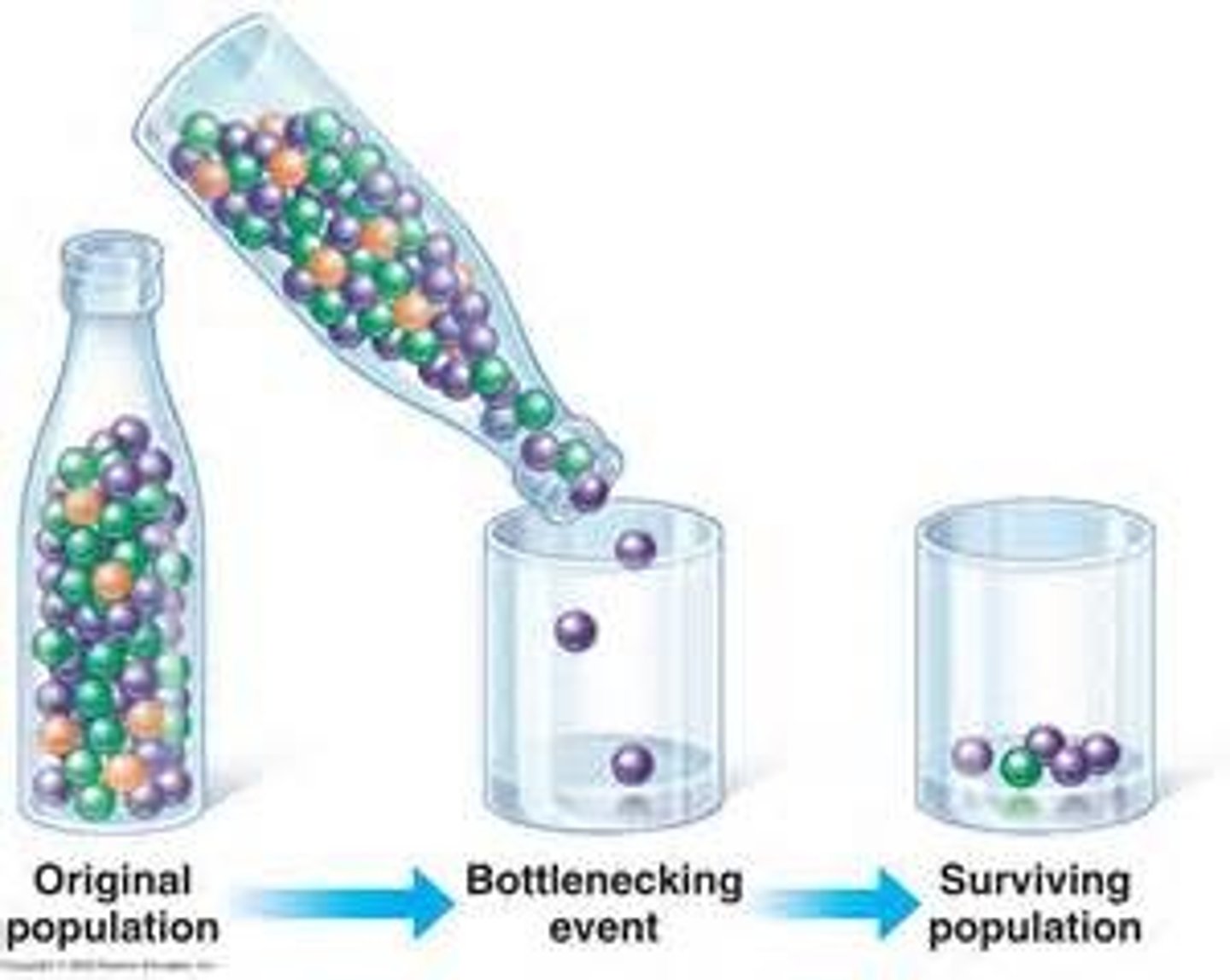
founder effect
change in allele frequencies as a result of some individuals becoming isolated from the rest of the population (darwin's finches; island colonies)
gametic isolation
Sperm of one species may not be able to fertilize eggs of another species
reduced hybrid viability
When the genes of different species interact and impair hybrid development.
3 types of postzygotic barriers
1. reduced hybrid viability
2. reduced hybrid fertility
3. hybrid breakdown
Mendelian Genetics
The branch of genetics concerned with patterns and process of inheritance. Dominant and recessive genes in one generation determine their proportions in the next generation
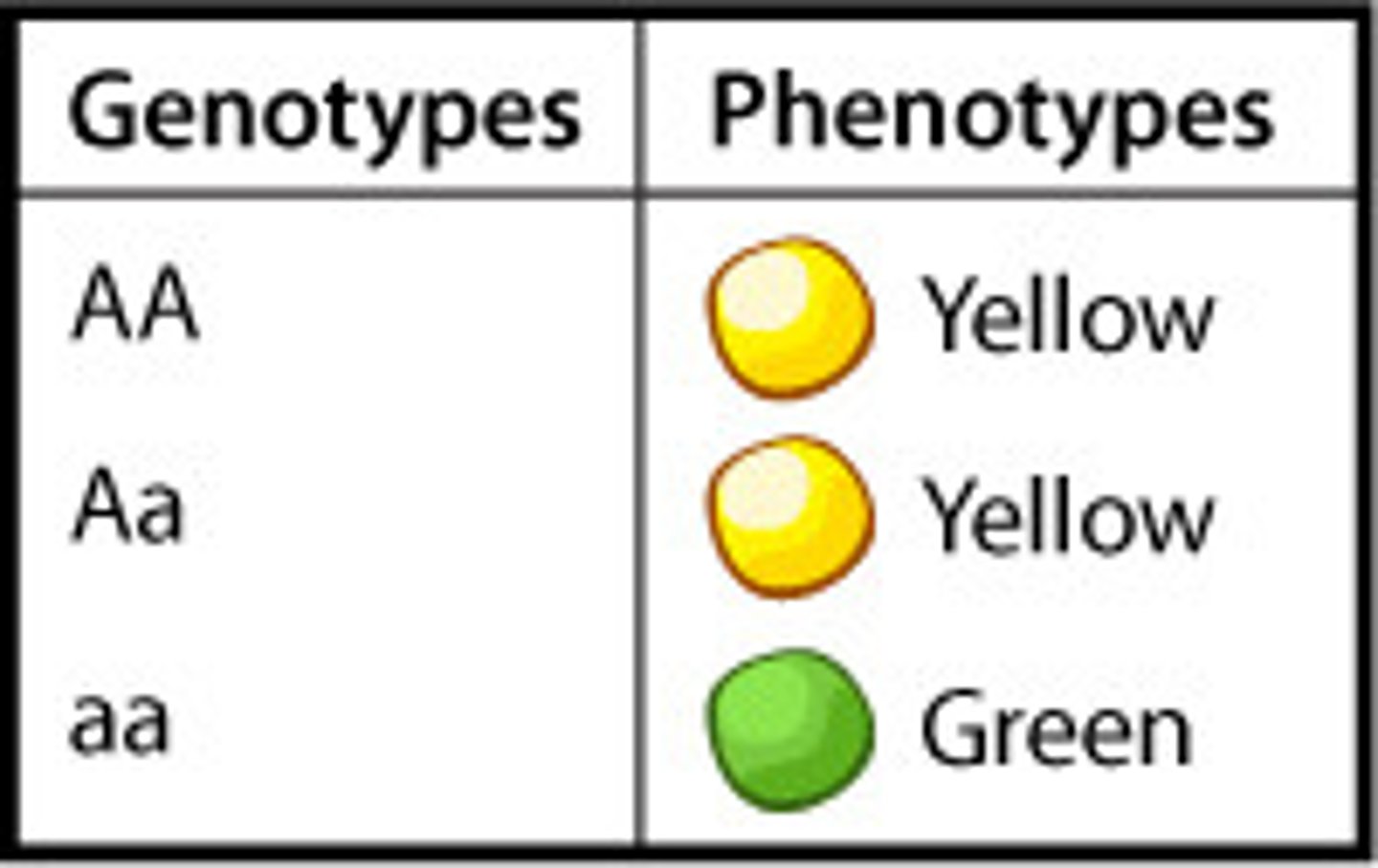
Heterocrony
changes in the rate of development/reproductive events in an organism's life - plays a significant role in the evolution of an organism's morphology
-onset/offset of a process, and the rate at which it occurs
allometric growth
The variation in the relative growth rates of various parts of the body, which helps shape the organism.
Who influenced Darwin?
Hutton and Lyell - gradual geological process and geological processes in the past still happening today: darwin's notion that change in species happens consistently over time
Lamarck: Use and disuse theory, acquired characteristics
Malthus: struggle for existence and competition for resources amongst humans: darwin applied to nature
how did darwin use hutton's theory
Hutton's principle of gradualism suggested that the Earth's surface features were shaped by slow processes. Darwin applied this concept of gradual change to his theory of evolution. He proposed that species could change over time through the accumulation of small, incremental variations, rather than through abrupt and catastrophic events.
speciation and isolation
Natural selection shapes differences between populations- when populations become geographically separated, each encounter selective pressures, leading to the evolution of distinct traits and adaptations. Over time, these genetic differences can accumulate to the point where interbreeding between the populations becomes limited or impossible; natural selection drives the adaptive divergence of populations, and it reinforces isolation mechanisms to maintain species boundaries.
How did Darwin use Lyell's theory
adopted the idea of deep geological time, recognizing that the Earth's long history provided time for evolution to occur. allowed for the slow accumulation of small changes over millions of years, which is a central component of his theory of natural selection.
punctuated equilibrium
Pattern of evolution in which long stable periods are interrupted by brief periods of more rapid change
Lamarck's Use and Disuse
the idea that parts of the body that are used extensively become larger and stronger, while those that are not used deteriorate
fitness
ability to survive and reproduce
Adaptation
A trait that helps an organism survive and reproduce
gene flow
Exchange of genes between populations through migration of individuals that breed with native species
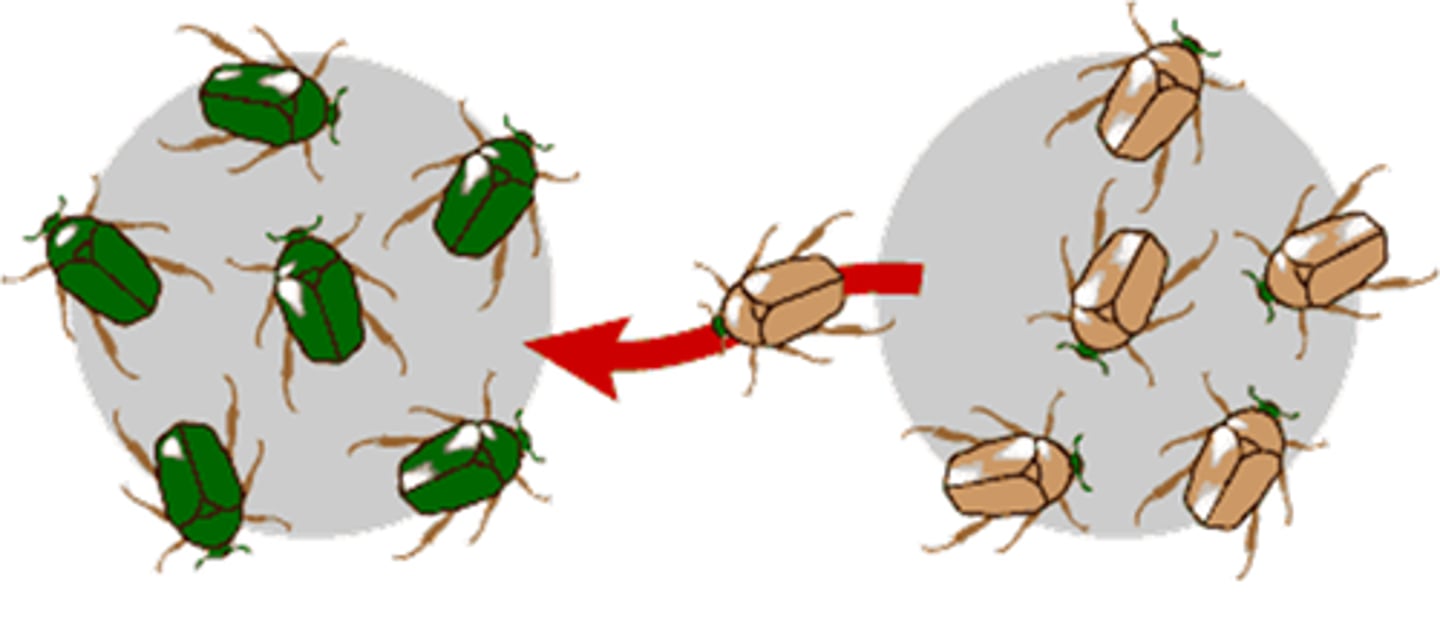
non-random mating
sexual selection, individuals choose desired traits in mates
speciation
Formation of new species
example of speciation: darwin's finches
-common ancestor of finches arrived on galapagos
- as ancestral finches spread they encountered diff ecological niches and food
- natural selection acted on finches in response to unique conditions
- variations in beak size/shape critical for feeding
-finches best adapted had more fitness and traits are passed
-differential adaptation and reproduction eventually led to many distinct species
what causes variations in poulations?
genetics is the basis for all variation in population
DNA
deoxyribonucleic acid, the material that contains the information that determines inherited characteristics
vestigial structures
remnant of a structure that may have had an important function in a species' ancestors, but has no clear function in the modern species.
adaptive radiation
the diversification of a group of organisms into forms filling different ecological niches.
ecological niches
role a species occupies within its ecosystem.how an organism interacts with both its living (biotic) and non-living (abiotic) surroundings. The niche of a species includes its interactions with other species, its preferred habitat, its diet, and its role in nutrient cycling and energy flow within the ecosystem.
Analagous Structures
Similar function but different structure - does not show common ancestry - Ex: butterfly wing and bat wing)
comparative embryology
the study of the formation, early growth, and development of different organisms
endemic species
species that are native to and found only within a limited area, provides evidence for reproductive isolation leading to speciation
microevolution
Change in genetic makeup of a population on a small scale from generation to generation.
modes of selection
directional, stabilizing, disruptive
Modes of Selection: Directional
environmental conditions favor individuals with one extreme variation of a trait, leading to a shift in the overall population toward that extreme - antibiotic resistant bacteria

sexual selection
preference towards specific traits in mates (usually males)
- more mating chances = passing favoured trait onto male offspring
- ex. colourful plumage in male birds
intrasexual selection
selection within the same sex, individuals of one sex compete directly for mates of the opposite sex
allopatric speciation
The formation of a new species as a result of an ancestral population's becoming isolated by a geographic barrier
-Gene flow stops between populations
-Most common
-Small populations = founder effect
sympatric speciation
The formation of new species in populations that live in the same geographic area because of reproductive isolation
-Mostly seen in plants as it's easier for them to self-fertilize
habitat isolation
Two species encounter each other rarely, or not at all, because they occupy different habitats, even though not isolated by physical barriers
temporal isolation
When two species breed at different times of day, season, or years.
behavioural isolation
when two populations are capable of interbreeding but have different behaviours such as courtship rituals or feeding.
mechanical isolation
Morphological differences can prevent successful mating
hybrid breakdown
Hybrid is fertile, but when they breed the next generation is sterile.
5 types of prezygotic barriers
habitat, temporal, behavioral, mechanical, gametic
Paedomorphism
The retention of juvenile features in the adult; though it is sexually mature and it's body development has stopped
Hox proteins
encode and specify the characteristics of 'position', ensuring that the correct structures form in the correct places of the body
why is reproductive isolation needed for a new species to form?
it prevents genetic mixing between different populations so each group can accumulate distinct genetic changes over time
Why can't two organisms occupy the same niche?
they would directly compete for the same resources within that niche (food, shelter, mates) - leads to depletion of resources - over time, one species may outcompete the other or both may evolve to occupy slightly diff. niches
niche
An organism's particular role in an ecosystem, or how it makes its living.
how do genes cause natural selection?
random mutations/genetic recombinations lead to genetic diversity, diff traits that affect fitness - natural selection favours certain traits that leads to more of that trait in future generations
convergent evolution
Process by which unrelated organisms independently evolve similarities when adapting to similar environments - both bats and birds have evolved the ability to fly, as they adapted to similar ecological niches and the advantages of flight; different lineages arrived at a similar solution to the challenges posed by the need for flight in their environments.
heterozygote advantage
Maintaining Genetic Diversity: helps maintain a balance between different alleles within a population. If one allele provides an advantage in some circumstances, and the other allele is advantageous in different conditions, heterozygotes will have the best chance of survival and reproduction across a range of environments.
Environmental Variability relevant in environments where conditions are unpredictable. may be advantageous for individuals to be able to adapt to a range of situations rather than being specialized for just one.
Linnaeus contribution
binomial nomenclature
Gradualism vs. Punctuated Equilibrium
Gradualism: organisms change gradually over time, punctuated equilibrium: stability that is interrupted by brief periods of more rapid change
common ancestry
Organisms that have a close genetic relationship with the same extinct species.
cladistics
A phylogenetic classification system that uses shared derived characters and ancestry as the sole criterion for grouping taxa.
prezygotic barriers
Barriers that impede mating or hinder fertilization.
reduced hybrid fertility
Chromosomes of parents may differ in number or structure and meiosis in hybrids may fail to produce normal gametes
population genetics
the study of how populations change genetically over time
- investigates how factors such as mutation, genetic drift, gene flow, and natural selection influence the distribution of genetic traits in populations.
Cuvier
catastrophism: believed that the extinction of species was caused by immediate catastrophic events
genetic drift
random change in allele frequencies that occurs in small populations
out-group
least related to other species
Alexander Oparin and J.B.S. Haldane
Proposed that the primitive atmosphere contained methane, ammonia, hydrogen, and water
molecular homologies
Molecular homology refers to the similarity in the genetic sequences or molecular structures of genes or proteins among different species, indicating a common evolutionary ancestry.
modern synthesis theory
a theory of biology in the early 20th century that unifies two crucial concepts in the field of biology - darwin's NS and Mendelian genetics - explains how species evolve over time by combining the process of NS which acts on inherited variations between organisms, within the mechanisms of genetic inheritance
Modes of Selection: stabilizing
extremes are diminished; intermediate traits are seen
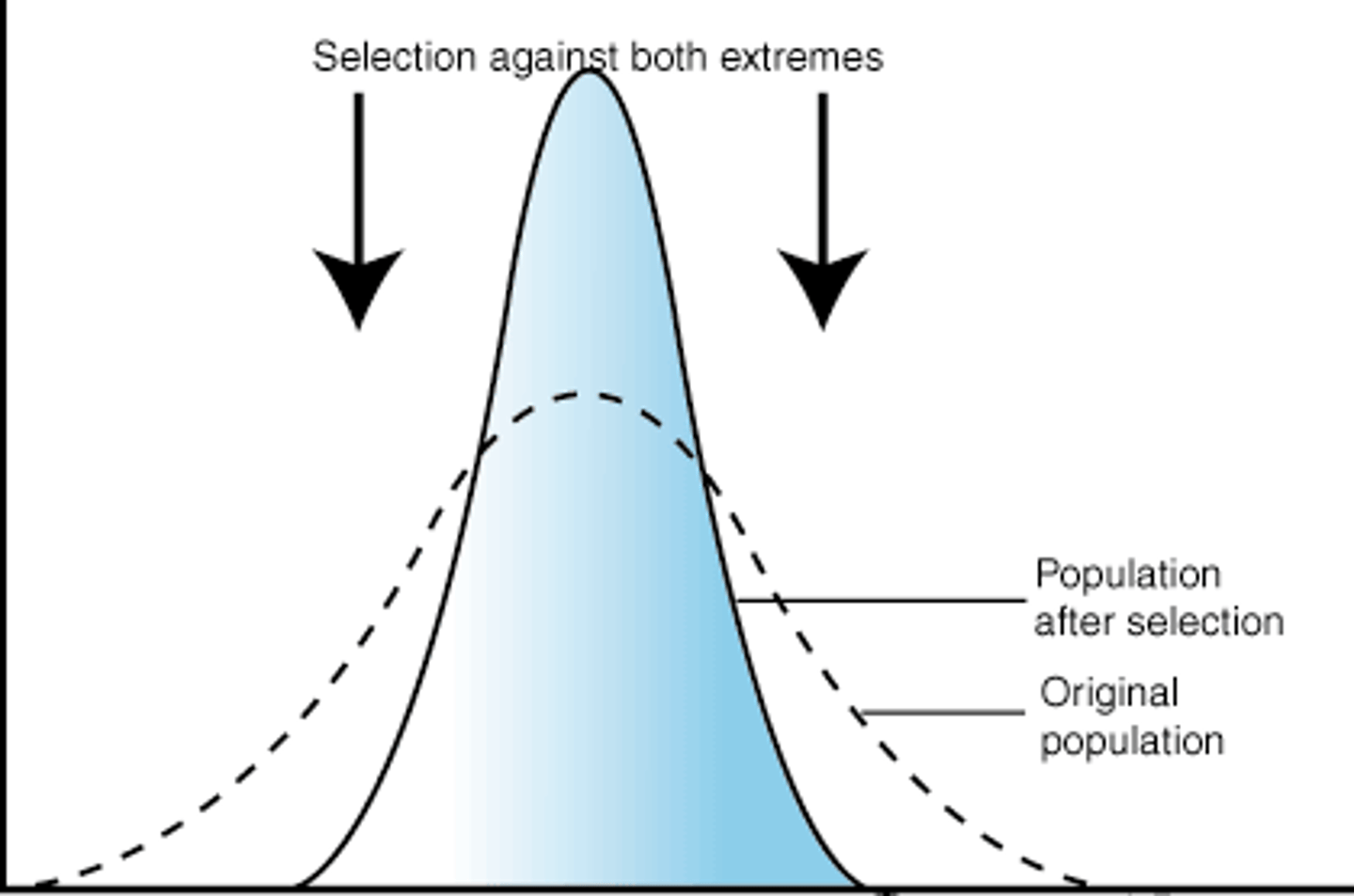
disruptive selection
extreme variations of a trait are favored over the intermediate form
Example: beak size of the Galápagos finches. During times of drought, when smaller seeds are less available, finches with smaller beaks are at a disadvantage. At the same time, finches with larger beaks can more effectively crack open larger, harder seeds. This leads to the survival and reproduction of birds with extreme beak sizes, resulting in a population with both very small-beaked and very large-beaked individuals.
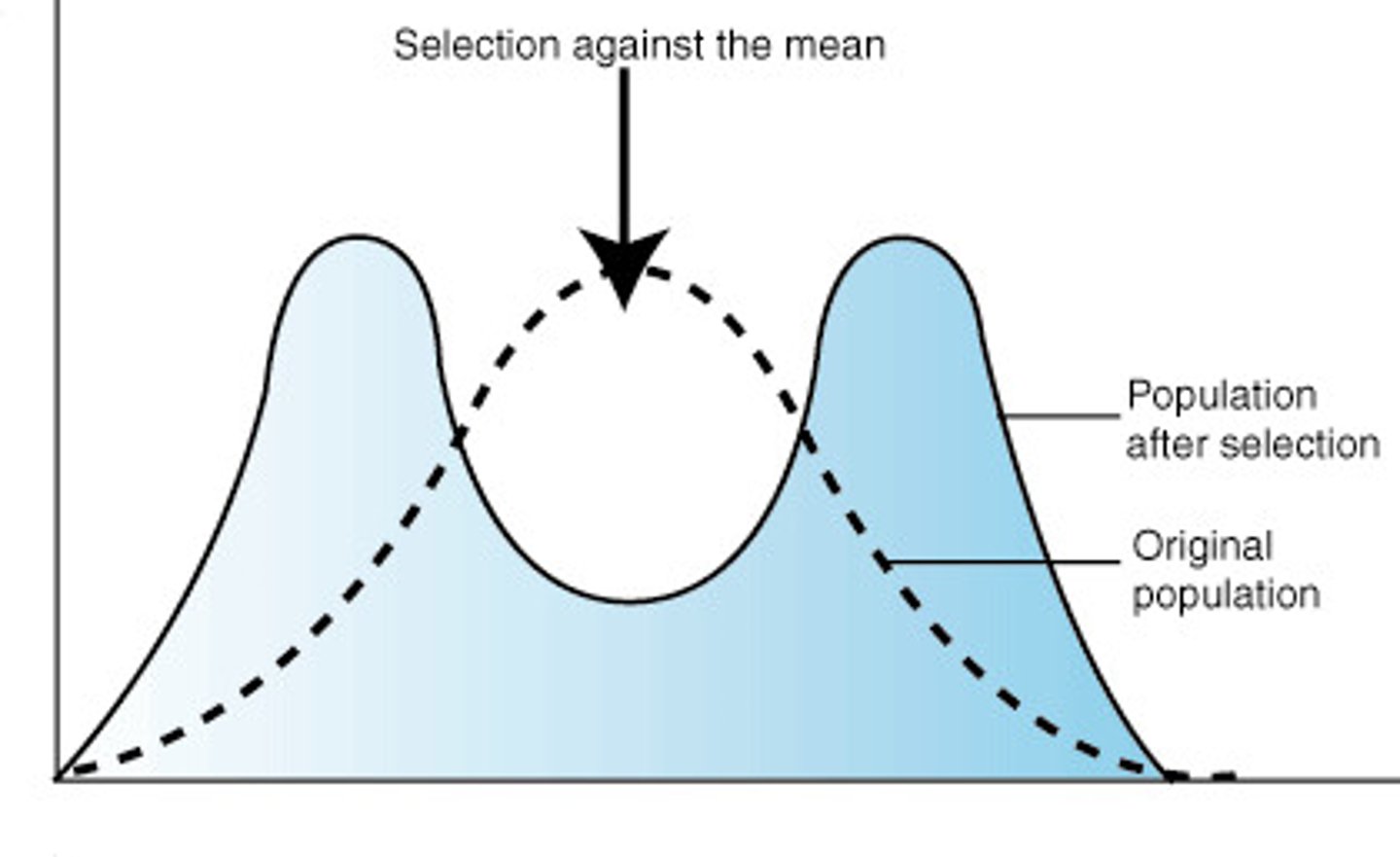
Polyploidy (sympatric speciation)
condition in which an organism has extra sets of chromosomes and is unable to mate with the rest of the population
postzygotic barriers
Barriers that prevent the hybrid zygote from becoming a fertile adult.
Homeotic (Hox) genes
genes that control the general body blueprint of an organism; highly conserved through evolution
divergent evolution
evolution of one or more closely related species into different species; resulting from adaptations to different environmental conditions